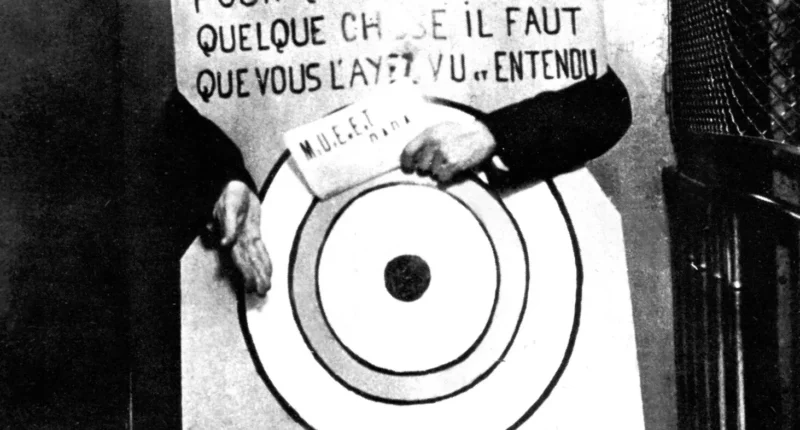This is not an article. It’s a fish in the shape of a piano, floating in a clear blue sky, seen through a keyhole.
Surrealism, the art movement that gave us disembodied eyeballs, melting clocks and animals with mismatched parts, was born in 1924 when the French poet André Breton published a treatise decrying the vogue for realism and rationality.
Breton argued instead for embracing the “omnipotence of dreams” and exploring the unconscious and all that was “marvelous” in life. Art that could reach beyond the rational could liberate humanity, he felt. “The mere word ‘freedom’ is the only one that still excites me,” Breton wrote in his “Surrealist Manifesto.”
It was a literary idea that became an art movement and revolutionized nearly all forms of cultural production. It’s now commonplace to call pretty much any weird experience “surreal.”
A century later, what does Surrealism still have to offer us? Do its philosophical and political arguments have anything to say about contemporary life? Do we still, even in the faintest way, hear that Surrealist commandment: “Transform the world, change life”?
Museum directors, curators and art historians around the world will attempt to answer such questions this year, and Surrealism exhibitions will be everywhere, all at once. From Paris to Fort Worth, from Munich to Gainesville, Fla., and all the way to Shanghai, art institutions are mounting shows that explore the movement.

In celebrating the centennial, curators are reclaiming Surrealism for today: Some are elevating the often-forgotten female Surrealists; others are connecting the dots to other art eras, like German Romanticism or early Netherlandish art; and some are focusing on Surrealism in photography and film.
The Pompidou Center in Paris, which owns one of the most extensive collections of French Surrealist art in the world, has organized the largest of the shows: a traveling exhibition that opened in Brussels on Feb. 21 and moves to Paris on Sept. 4. The show then goes to Hamburg and Madrid, and wraps up at the Philadelphia Museum of Art in 2026.
By lending those museums about 30 major artworks by Salvador Dalí, Giorgio de Chirico, Max Ernst and Man Ray, the Pompidou is giving each institution a base upon which to develop its own Surrealism show, and each will have a different focus.
The first iteration — “Imagine! 100 Years of International Surrealism,” at the Royal Museums of Fine Arts of Belgium through July 21 — links Surrealism with Symbolism, a 19th-century precursor movement with a similar disdain for realism.
With all these interpretations of Surrealism floating around, it can seem difficult to pinpoint a definition of the term. What most experts agree on is that Surrealism wasn’t necessarily about art.
“I hope that people will discover that Surrealism is a state of mind and a way of looking at things,” said Francisca Vandepitte, who curated the show at the Royal Museums. “It’s not something theoretical and very complicated. The main force is something that we all know. It’s irrational, and it’s our dreams, and it’s liberating.”

Invented in Europe in the wake of World War I, and following a flu pandemic, Surrealism embraced Freud’s theories of the unconscious, rejected authoritarianism and colonialism, and, at first, espoused communism, though many followers later rejected it.
Although Breton’s circle was mostly in Paris, Surrealism’s signature adherents were spread internationally: Dalí and Miró were Spanish, de Chirico was Italian, Magritte was Belgian, Leonora Carrington was British and Frida Kahlo was Mexican.
Even as Surrealism’s centennial is celebrated this year, some art historians see it as a much older impulse that runs like an electrical current throughout art history, with jolts in the Middle Ages, between the two World Wars, in the postwar era and in the 1960s.
“The Surrealists went back in history and claimed people like Hieronymus Bosch, or Giuseppe Arcimboldo, and said these were Surrealists before there was Surrealism,” said Robert Zeller, the author of “New Surrealism: The Uncanny in Contemporary Painting.”

“Other art movements said, ‘History is bunk and we want to start at year zero,” Zeller added. “The Surrealists saw themselves as having had a legacy going backwards and forwards.”
Zeller also pointed out that the origins of Surrealism are not entirely unambiguous. Besides Breton’s manifesto, there was another “Manifesto of Surrealism,” written by the poet Yvan Goll, the leader of another Surrealist faction, and published a month before Breton’s. Goll rejected the Freudian aspect of Breton’s vision, and argued for a Surrealism grounded in reality, but taken to “a higher plane.”
Around the same time, the Belgian poet Paul Nougé also published his own Surrealist tracts called “Correspondence,” which are on display at an exhibition in Brussels at the Bozar art center.
Xavier Canonne, the show’s curator, said that Nougé should be regarded as a founder of Surrealism on par with Breton. “If there is one thing I’d like to come out of this show, it’s that people discover Paul Nougé,” he said. “And that people from outside Belgium discover that there was a real movement of Surrealism in Belgium for more than 70 years.”
Nougé influenced René Magritte to shift from abstraction to surrealism, Canonne said, and Nougé also established a Surrealist center in Brussels that attracted many other artists to the movement, even as Magritte moved to Paris in 1927 to join Breton’s followers.

Patricia Allmer, an art history professor at the University of Edinburgh, said that this contest for ownership reflects how flexible and adaptable Surrealism’s basic principles could be.
“Surrealism was indeed, from its beginnings, a multiplicity,” she said. “Breton’s manifesto became the famous one,” she said, but “you can’t claim it as a movement. It’s a plurality. That’s why it’s so rich and so malleable: It can be used by different artists in different contexts.”
Allmer also said that Surrealism didn’t find its most profound uses until female artists adopted its methods in the post-World War II era, as she plans to show in an exhibition she is curating later this year at the Henry Moore Institute in Leeds, England.
“Breton always emphasized the Surrealism breaks boundaries, but it often excluded women,” Allmer said. “Women artists took the truth of Surrealism to make feminist political statements and push beyond the gender boundary.”

The notion that art should be ideological, rather than representational, is central to the Surrealist spirit, said Mark Polizzotti, whose book “Why Surrealism Matters” was published in January, he describes Surrealism as “a disrupter,” and a way of thinking that “perpetually challenges the existing paradigms and seeks new forms to maintain its emotional intensity.”
Polizzotti points to the Surrealists’ objection to French colonialism and racism, which he said were similar to the current discussions about racial equality and social justice. In his book, he quotes Breton’s declaration “Surrealism is allied with people of color, because it has always been on their side against every form of white imperialism and banditry.”
In an interview, Polizzotti said: “We’re in a world today that’s not unlike the world in which they emerged. We came out of a pandemic, there are questions about labor reform and anti-colonialism and exhibition strategies in the art world. These were things they were grappling with as well.”
The Pompidou’s exhibition will end with the death of Breton in 1966, but the show’s curator, Didier Ottinger, acknowledged that this wasn’t Surrealism’s final chapter.

Acolytes of the Surrealists “tried to keep the idea of Surrealism alive for a few years,” he said. But in October 1969, one of its leaders, Jean Schuster, announced the formal dissolution of the Surrealist group in the French newspaper Le Monde.
Many artists refused to accept this death decree, and wrote in protest to Le Monde. “Letters came flooding in from all over the world from artists who said, ‘No, we are alive,’” Ottinger said. “So, as long as there were more artists, it could not die.”
Polizzotti said that Surrealism continued to extend into other art forms, like the tragicomic Theater of the Absurd and the bizarre skits of the British comedy troupe Monty Python. Surrealist tendencies also appear in the cinematic world of David Lynch, whose films, like “Eraserhead” and “Mulholland Drive,” dive into dark psychosexual desires that lie beneath the surface of a seemingly tranquil world.
And it has certainly not died in the fine arts, either. In Zeller’s book, he identifies about 30 “New Surrealists,” including the Polish painter Ewa Juszkiewicz, who makes portraits of women covered in plants, and the Taiwanese artist Lin Shih-Yung, who paints humans with bananas for heads.
“It’s the transformative nature of Surrealism that continues to make it relevant,” Allmer said. “Surrealism is inherently political. It started as a protest movement and a way to counter fascism and authoritarianism, so that’s why it still can be a very powerful political weapon for today. It will always be relevant. I would say, it’s a future movement.”






